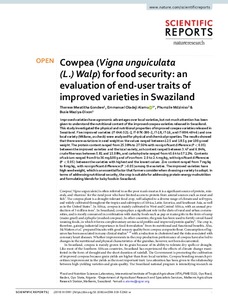| dc.contributor.author | Gondwe, T. |
| dc.contributor.author | Alamu, E.O. |
| dc.contributor.author | Mdziniso, P. |
| dc.contributor.author | Maziya-Dixon, B. |
| dc.date.accessioned | 2019-12-04T11:39:09Z |
| dc.date.available | 2019-12-04T11:39:09Z |
| dc.date.issued | 2019-11-05 |
| dc.identifier.citation | Gondwe, T., Alamu, E.O., Mdziniso, P. & Maziya-Dixon, B. (2019). Cowpea (Vigna unguiculata (L.) Walp) for food security: an evaluation of end-user traits of improved varieties in Swaziland. Scientific Reports, 9(1), 1-6. |
| dc.identifier.issn | 2045-2322 |
| dc.identifier.uri | https://hdl.handle.net/20.500.12478/6552 |
| dc.description | Open Access Journal |
| dc.description.abstract | Improved varieties have agronomic advantages over local varieties,but not much attention has been given to understand the nutritional content of the improved cowpea varieties released in Swaziland. This study investigated the physical and nutritional properties of improved cowpea varieties released in Swaziland. Five improved varieties (IT-04K-321-2, IT-97K-390-2, IT-18, IT-16, and IT-99K-494-6) and one local variety (Mtilane, as check) were analyzed for physical and chemical properties. The results showed that there were variations in seed weight as the values ranged between 12.5 and 18.5 g per 100 g seed weight. The protein content ranged from 25.38% to 27.56% with no significant difference (P < 0.05) between the improved varieties and the local variety, ash content ranged between 3.47 and 6.84%, crude fiber was between 5.81 and 15.08%, and carbohydrate ranged from 45.64 to 57.12%. Contents of calcium ranged from 9 to 36 mg/100 g and of iron from 2.0 to 2.4 mg/kg, with significant differences (P < 0.05) between the varieties with highest and the lowest values. Zinc content ranged from 7 mg/kg to 8 mg/kg, with no significant difference (P >0.05) among the varieties. The improved varieties have high seed weight, which is an essential factor that farmers consider when choosing a variety to adopt. In terms of addressing nutritional security, the crop is suitable for addressing protein-energy malnutrition and formulating blends for baby foods in Swaziland. |
| dc.description.sponsorship | CGIAR Crop Research Program |
| dc.format.extent | 1-6 |
| dc.language.iso | en |
| dc.rights | CC-BY-4.0 |
| dc.subject | Cowpeas |
| dc.subject | Food Security |
| dc.subject | Evaluation |
| dc.subject | Drought Tolerance |
| dc.subject | Soil |
| dc.subject | Grain |
| dc.subject | Yields |
| dc.subject | Nutritional Requirements |
| dc.title | Cowpea (Vigna unguiculata (L.) Walp) for food security: an evaluation of end-user traits of improved varieties in Swaziland |
| dc.type | Journal Article |
| dc.description.version | Peer Review |
| cg.contributor.crp | Agriculture for Nutrition and Health |
| cg.contributor.crp | Climate Change, Agriculture and Food Security |
| cg.contributor.crp | Maize |
| cg.contributor.crp | Grain Legumes |
| cg.contributor.affiliation | International Institute of Tropical Agriculture |
| cg.contributor.affiliation | Malkerns Agriculture Research Station, Swaziland |
| cg.creator.identifier | Therese Gondwe: 0000-0002-4522-7060 |
| cg.creator.identifier | Alamu Emmanuel Oladeji: 0000-0001-6263-1359 |
| cg.researchtheme | NUTRITION & HUMAN HEALTH |
| cg.researchtheme | PLANT PRODUCTION & HEALTH |
| cg.isijournal | ISI Journal |
| cg.authorship.types | CGIAR and developing country institute |
| cg.iitasubject | Agronomy |
| cg.iitasubject | Cowpea |
| cg.iitasubject | Food Security |
| cg.iitasubject | Maize |
| cg.iitasubject | Nutrition |
| cg.iitasubject | Plant Health |
| cg.iitasubject | Plant Production |
| cg.journal | Scientific Reports |
| cg.howpublished | Formally Published |
| cg.accessibilitystatus | Open Access |
| local.dspaceid | 110114 |
| cg.targetaudience | Scientists |
| cg.identifier.doi | https://dx.doi.org/10.1038/s41598-019-52360-w |

